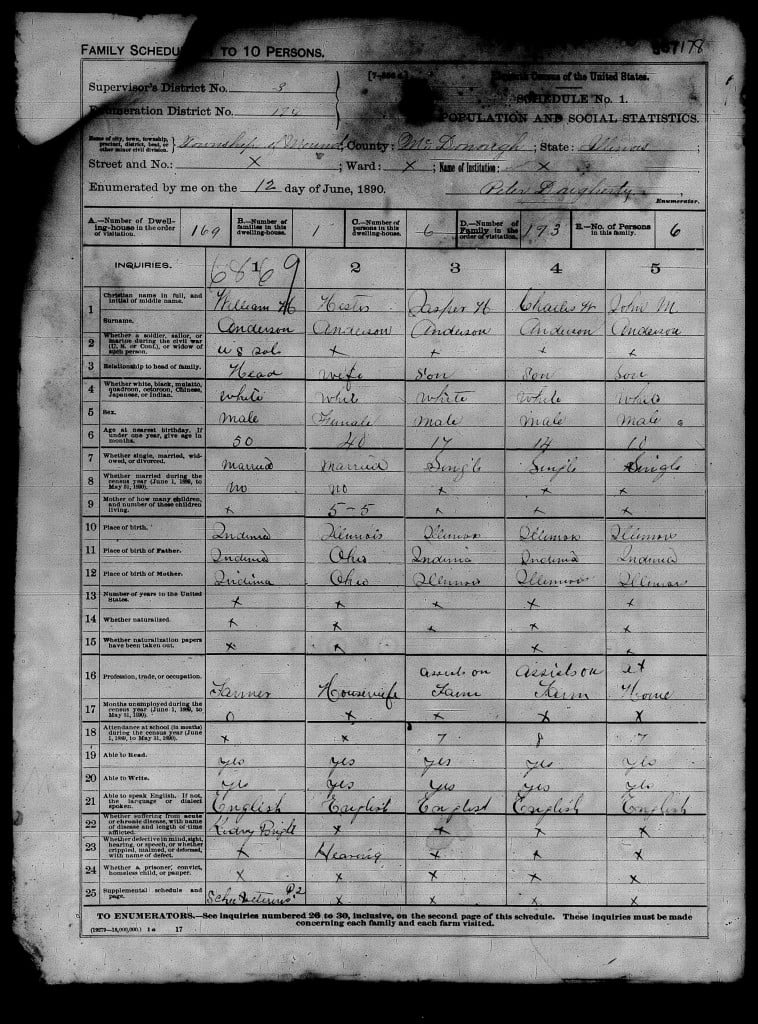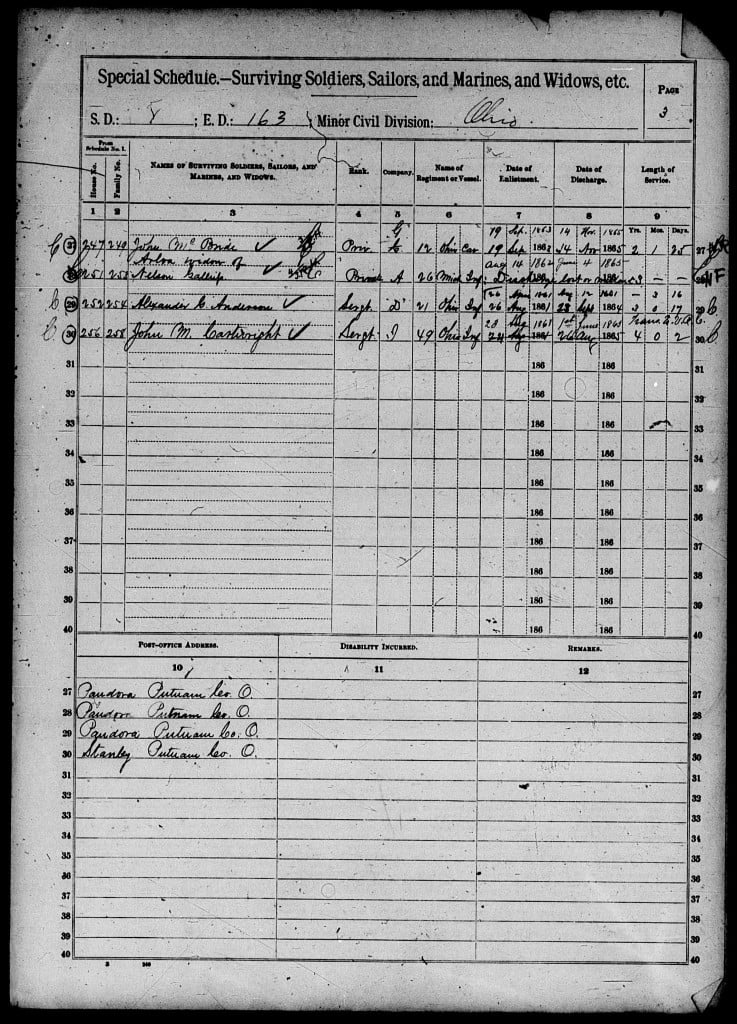Many family historians are fully aware of the fact that the 1890 census, which contained more than 60 million individuals, was destroyed in the early 20th century and is therefore not available for genealogical research. The lack of this valuable resource, one from such an important time in America’s history, has left a huge gap for many of us.
Despite the common belief that these precious records were simply destroyed by fire in 1921 the actual story of what happened is quite surprising and somewhat disturbing. You can read all about it in this article on Family History Daily. But there is another twist to this story — some of these records DO still exist and they can be accessed online for free.
There are two parts of the 1890 census that can still be accessed and both are very valuable in their own way. The first is a fragment of the main population census and the second is a special veterans and widows enumeration that was completed alongside the main 1890 census.
While the first collection contains just over 6,000 individuals, it could still be hugely helpful to a researcher who is lucky enough to have had ancestors who lived in the geographical locations that were saved.
The second section, the special enumeration of Union (and some Confederate) veterans, is very large and 90,000+ images are offered online.
Read on to find out how to access both of these sections of the 1890 census.
The 1890 Census Fragment
FamilySearch offers the complete 1890 census fragment online. Both a searchable index and images are available. Because only about 2000 images remain, including just over 6,000 individuals, you will want to check available locations before beginning a search.
According to The National Archives, the available locations are:
- Parts of Perry Co., Alabama
- Parts of the District of Columbia
- Columbus, Muscogee Co., Georgia
- Mound Twp., McDonough Co., Illinois
- Rockford, Wright Co., Minnesota
- Jersey City, Hudson Co., New Jersey
- Eastchester, Westchester Co., New York
- Brookhaven Twp., Suffolk Co., New York
- Parts of Cleveland Co., North Carolina
- Parts of Gaston Co., North Carolina
- Cincinnati, Hamilton Co., Ohio
- Wayne Twp., Clinton Co., Ohio
- Jefferson Twp., Union Co., South Dakota
- Parts of Ellis Co., Texas
- Parts of Hood Co., Texas
- Kaufman, Kaufman Co., Texas
- Parts of Rusk Co., Texas
- Trinity Town and parts of Trinity Co., TX
For more detailed information see the list on this page.
To find these records online visit this section of FamilySearch where you can search them easily. If you locate a record of interest you can view a transcript and image like the one seen above.
If you have spent any time doing census research you will also notice that the images look quite different than other enumerations. The 1890 census was the only one to include just one family per page. It also used a vertical layout with wider columns.
If you are lucky enough to be able to locate an ancestor in this precious record set you will find a good deal of helpful information, as with any US census. Names, relationships, occupations, military service information and more are just waiting to be discovered.
The 1890 Census of Union Veterans and Widows of the Civil War
This remaining section of the 1890 census is even more valuable because it is so vast. The US government had several reasons for conducting this special enumeration of Union veterans and their widows and, luckily, much of it has survived.
The National Archives explains the motivation behind this special enumeration:
The Pension Office requested the special enumeration to help Union veterans locate comrades to testify in pension claims and to determine the number of survivors and widows for pension legislation. Some congressmen also thought it scientifically useful to know the effect of various types of military service upon veterans’ longevity.(28) To assist in the enumeration, the Pension Office prepared a list of veterans’ names and addresses from their files and from available military records held by the War Department. The superintendent of the census planned to print in volumes the veterans information (name, rank, length of service, and post office address) compiled from the 1890 enumeration and place copies with libraries and veterans organizations so individuals could more easily locate their fellow veterans.(29) Read more about it here.
Although the goal was to record Union veterans and widows, some Confederate soldiers were also included so check this database even if your ancestor fought on the side of the south.
Unfortunately, the records for the states of Alabama through Kansas (alphabetically) are now mostly lost, but records remain from all states from Kentucky through Wyoming.
This includes:
- U.S. Navy Vessels and Navy Yards
- Washington, DC
- Kentucky (part)
- Louisiana
- Maine
- Maryland
- Massachusetts
- Michigan
- Minnesota
- Mississippi
- Missouri
- Montana
- Nebraska
- Nevada
- New Hampshire
- New Jersey
- New Mexico
- New York
- North Carolina
- North Dakota
- Ohio
- Oklahoma and Indian Territories
- Oregon
- Pennsylvania
- Rhode Island
- South Carolina
- South Dakota
- Tennessee
- Texas
- Utah
- Vermont
- Virginia
- Washington
- West Virginia
- Wisconsin
- Wyoming
Because this record set contains a vast number of individuals there is a good chance that you may locate an ancestor. Finding one means access to information on that veteran’s name (or widow’s name and her deceased husband’s name), rank, date of enlistment, date of discharge, address, disability incurred by the veteran, special notes and more.
To find this valuable resource (and helpful substitute to the lost 1890 census) for free visit this page on FamilySearch where you can search and view the transcripts and images.
Happy hunting!
You might also like:
The Forgotten Federal Census of 1885 Can Be Found Online for Free
The Ultimate Quick Reference Guide to the U.S. Census
Image: A Census Bureau employee using a Hollerith tabulator in 1908. The Hollerith tabulator was first used for the 1890 census. Photo courtesy of the Library of Congress via Census.gov.
By Melanie Mayo, Family History Daily Editor



Just USA records.Looking for Canadian records also.
You should check a unit history of his regiment. He may have enlisted in the first formation of the regiment, but then after losses, that regiment hay have been absorbed into another and he may have had another’s mustering in at that time. Some regimental histories include rosters of members which can also be a help.
When I finally got a chance to check this out, I was all excited to see Jersey City, NJ on the list of sites for the regular 1890 census, as my mom’s family (both sides) lived there. I wasn’t surprised not to find the Italians (I think they were in NYC in 1890) but the Irish definitely went directly to JC in the 1880s. After trying a few names spelled a few ways, I tried with only Residence = New Jersey, thinking I would just plug away at what I got back. There were 17 records. How disappointing. A little descriptor saying “part of” would be nice when the result is so limited. In any case, I hope my comment will save someone else from getting their hopes up as I did.
The veterans records seem to be the gold mine, and since all of my ancestors arrived in the US after the Civil War, it appears I’m out of luck for my own family. They will likely help, however, with my stepfather’s tree!
Yes, I’ve found right away my Nathaniel A. Beal of Lisbon, Maine! And Benjamin H. Beal of Bowdoin, Maine, is probably mine, too. I’ll be looking for others. No luck so far in Vermont. Thanks, it’s great to know about this!
This record told me that my Civil War ancestor was “wounded in right leg while on duty”. I don’t recall seeing that nugget of info before, including in his Army record. Cool!
Thanks! Managed to find 2 of 6 of my Civil War veteran relatives. What a great resource!
Found my great-great grandfather served for the union 1862-65!
One more link found, thank you.
Henry Lee Borden, son of Borden Milk founder, had a summer home in Michigan. One day he and his wife did their civic duty and registered. His Civil War service info was written down, but it was discovered that he had been a Confederate and a line was drawn through his name. His wife, however was a widow of a Union veteran and her previous husband’s information appears on the next line. This was a huge find for me!
From where did the enlistment and discharge dates come? Had they been checked against military records or were they supplied by the soldier from memory? I ask because the ones for John C Heller, Calumet, WI don’t make sense. It says he enlisted in Nov 1863 and was discharged in Aug. 1864 [I enlarged until years were clear]. 8 months and 26 days, 8 months (family story says 7) of which he spent in Andersonville prison! But the company he was with was formed from Sept.1861-Feb.1862 and left state in Mar 1862. [from background reading]. Were replacements sent periodically?
Have used the 1890 Veterans schedule for research on the many US Colored Troops who are buried in area cemeteries. Luckily, our county in Kentucky was one that survived.
ALSO, the ORIGINAL copy of 1890 for Waterville, Maine, survived in the city’s public library, and was transcribed and published several years ago. I wonder how many other libraries might have the originals before they were copied and sent on to Washington…
Terry, are you referring to the Notify Me box for the upcoming genealogy course? We have tested it and it does seem to be working now, but if you are still having problems please feel free to email us at [email protected] and we’ll get you added to the list. Thanks for your interest,
We apologize for the broken link to the census fragment. We have fixed it in the article. The URL is https://familysearch.org/search/collection/1610551
Link does not work. Please advise.
I found my ghost of a 3x grgrandpa on the veterans census in Missouri. Im waiting on his pension application to tell me when and where he was born and died!
I couldn’t get the notify section to work
Apparently the link in the following paragraph does not work: To find these records online visit this section of FamilySearch where you can search them easily. If you locate a record of interest you can view a transcript and image like the one seen above.
Can you please provide the URL for the FamilySearch location of the records.